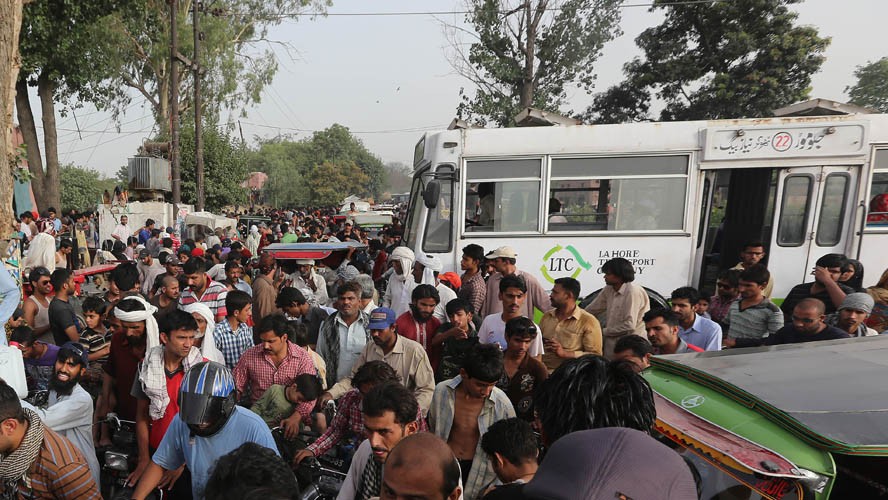
Is the current model of development sufficient to hold the city of Lahore together from crumbling?

There was time when the Ravi River fed an entire city sprawling on its eastern bank. The produce from the city gardens and agricultural land around were enough for the citizens, the air was clean, and the city provided a good economic model for growth.
Unfortunately, where the Ravi was once the trading and transport artery, lately it has suffered neglect as roads and evolving trading patterns have supplanted the river’s economic and social functions.
The decline of Lahore’s sustainable model has been accompanied by environmental destruction, as its waters have become polluted and serve as the dumping ground for solid waste. Moreover, riverbank settlements evolved into legally ambiguous spaces, as old settlements were detached from land formalisation regimes and subjected to environmental deterioration from the rivers.
Far from being an asset, the Ravi has become an eyesore -- and occasionally also a threat, owing to flooding exacerbated by poor planning and a poor understanding of the place of the river in the wider regional eco-system. Surely, the case study of Ravi serves as a microcosm for a recipe of Lahore’s urban disaster.
Lahore’s degradation can be ascertained by the massive urban sprawl the city has witnessed over the past couple of years. According to the 6th population census conducted in 2017, Lahore’s population grew roughly twice as fast as that of Karachi. Even more frightening is the fact that from 1998 to 2017, Lahore’s population grew by 116.3 percent, as compared to Karachi’s 59.65 percent. The question arises whether the current model of development is sufficient to hold the city together from crumbling. As the city has already hit its saturation mark for having around 11.13 million within its 1.772 square-kilometers of area, the answer will surely be in negative.
The flagrant neglect of town planning and a haphazard development mantra of the city has led to urbanisation with its attendant consequences such as insecure land tenure, poor and inadequate infrastructure, pollution, health challenges, poverty and lack of basic urban services.
No wonder the country has been ranked 147 out of 188 countries in the Human Development Index, which pushed its stumbling pursuit further away from achieving the Sustainable Development Goals (SDGs 2016-2030), as it scored 55.6 under SDGs’ global index in the results released in July last year. With worst figures in Human Development Index and most indicators lower than most countries in South Asia, Pakistan is ranked 122 on the SDG index of 157 nations.
In a recent study released in April 2018, spearheaded by the United Nations Human Settlement Programme (UN Habitat), titled ‘The State of Pakistani Cities,’ 10 major cities in Pakistan make up more than half -- 54 percent -- of the total national urban population. Lahore stands second to Karachi on the list.
The study also sheds light on how cities vary in terms of the size of their economy, employment, and tax revenues, and explains that services and industry are the major employment sectors. As compared to its high population growth, Lahore contributes only 15 percent share of its services economy to the national exchequer, as opposed to 55 percent of Karachi and Islamabad’s 16 percent.
Whereas the Sustainable Development Goal 11 (SDG 11) on sustainable cities and communities puts much emphasis on the need to reduce the adverse per capita environmental impact of cities by paying special attention to air quality, in the management of municipal and other waste products the managers of Lahore are found looking in the opposite direction for answers.
With only five percent of its area covered with trees, Lahore is ranked among the top 10 polluted cities of the world, when it comes to the Air Quality Index (AQI). Unregulated industrialisation in the suburbs of the city, ill-planned urban sprawl, and the massive cutting of trees for development activities has tipped the balance of nature. Connecting to SDG 11, these urban green spaces which are being encroached upon could have played an important role in improving the overall air quality, could have contributed to flood management, replenished the ground water resource of the city, mitigated the Urban Heat Island effect, and boosted the mental and physical well-being (enshrined in SDG3) of the residents. But unfortunately, this is not the case.
Furthermore, our development model has discouraged the city’s initial choice of transportation into suboptimal transport policies biased towards private vehicles and roads which now resists change to a more sustainable transport policy. While we can boast about our recent achievements of running metros, albeit their negative impact on the environment, studies by the provincial government reveal that the city still requires approximately 1,400 buses to cater to the needs of its population.
Moreover, the city is currently pumping more than 160 million litres of ground water per day. This has resulted in the fast depletion of groundwater level at a rate of 2.5 to 3 feet per year. It is feared that at this rate the groundwater levels will drop from 130 feet to 230 feet by the year 2030.
It can be understood that the city is lagging behind in achieving a sustainable model. With natural resources already exhausted, it is more worrisome that the administration is not even trying to address the issue. The transformation towards a resilient and sustainable society requires redesigning our city as well as a radical shift in our patterns of production, consumption, and waste. At the city level, the solution comes down to better planning and management of our urban growth. The objective should be to create a better living environment, maintain agricultural land, access to basic urban services related to water, sanitation, housing, and health, besides improving the quality of services provided to citizens; and, finally, creating conditions for a balanced economic growth.